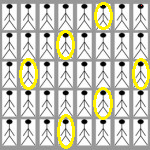
Let’s say you wanted to find out how many people in the United States are women. According to the Census bureau, that figure — the population percentage — is 50.5%. But it’s not often that kind of data is available, so you may need to conduct a survey to estimate this information.
Sample Percentage Example
If you wanted to find out the percentage of females that feel comfortable going to the gym, it’s unlikely you’ll have access to every gym’s membership roll, so you may need to survey a proportion of females who have gym membership.
Fitness company DNA conducted one such survey and found that almost 75% of women have felt uncomfortable in a gym. As the company only asked 400 women (and not all of the estimated 5 million women in the UK who have gym memberships), that “75%” is a sample percentage. If the survey company had the means to take a census — asking all 5 million women with gym memberships if they felt comfortable or not — then that would have been a population percentage.
Assuming that the company used a random sampling method, the sample percentage can be used to estimate the true population percentage, although it’s highly unlikely that the sample percentage will be exact. We can calculate the error with the standard error of the sample percentage. This gives us the confidence interval, which is the sample percentage ± a certain number of standard errors [1].